Parakeet Care: A Comprehensive Guide for Bird Owners
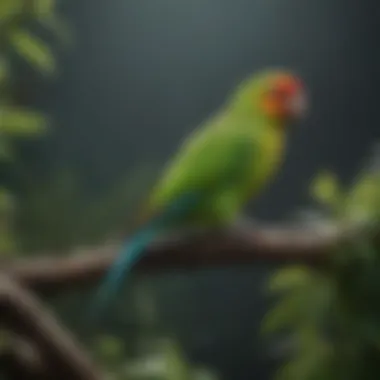
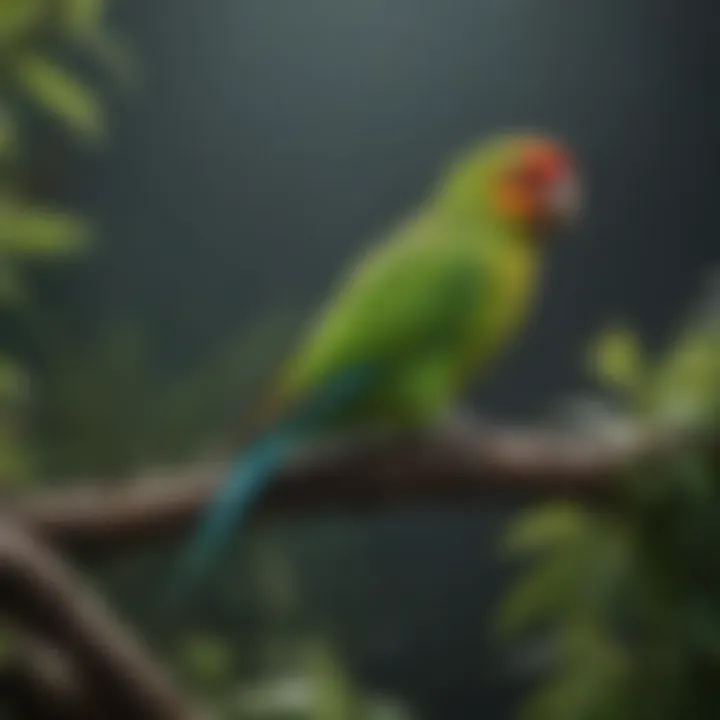
Intro
Parakeets make for delightful companions. Their vibrant plumage and cheerful chirps add life to a home. However, understanding the nuances of their care is essential for any bird owner. This guide is structured to provide extensive insight into various aspects of parakeet care. By familiarizing oneself with the needs and behaviors of these intelligent birds, owners can create an enriching environment that promotes their health and happiness.
Care Tips
Taking care of a parakeet requires consistency and awareness of their specific needs. A structured routine helps maintain a thriving atmosphere for them.
Daily Care Routines
Establishing a daily routine is vital. Begin each day by providing fresh water and a balanced diet. Parakeets often enjoy seeds, pellets, and fresh fruits and vegetables. Also, ensure they receive ample time outside their cage to exercise and explore.
Cage Setup and Maintenance
A well-designed cage is crucial. Parakeets need space to move around and play. Depending on the species, a cage should ideally be wide enough to allow flight, as it helps maintain their physical well-being. Regularly check the cage for wear and tear, replacing perches and toys as needed to keep the environment engaging and safe.
Hygiene and Cleaning Practices
Cleanliness is key to your parakeet's health. Daily spot cleaning can prevent the buildup of waste. A thorough cleaning of the cage, including the food and water containers, should be done weekly. Use bird-safe cleaners to maintain hygiene without exposing them to harmful chemicals.
Seasonal Care Adjustments
Changes in temperature and humidity require different care approaches. During colder months, ensure that the cage is kept in a warm area. In summer, provide ample opportunities for bathing and hydration to help them cope with heat. Adjust their lighting schedule as well to mimic natural cycles.
Behavioral Insights
Understanding parakeet behavior is essential in fostering a trusting relationship and addressing any issues.
Understanding Bird Body Language
Parakeets communicate through their behavior. Understanding their body language can help in recognizing their emotional state. For instance, fluffed feathers may indicate fear or discomfort, while an alert stance and chirping signals curiosity and interest.
Common Behavioral Issues and Solutions
Behavioral problems may arise if their needs are not met. For instance, excessive screaming might be a sign of boredom or loneliness. Engaging them in varied activities can mitigate this issue. If aggression occurs, it may be a response to stress; evaluating their environment helps address the root cause.
Positive Reinforcement Techniques
Positive reinforcement fosters good behavior. Reward your parakeet with treats or affection when they exhibit desirable actions. This builds a stronger bond and encourages learning.
Social Interaction Needs
Parakeets are social creatures. They thrive on interaction with their owners or even other birds. Spending time with them enhances their well-being. They enjoy verbal communication and can even learn to mimic sounds.
Nutrition Guides
Nutrition is a fundamental aspect of parakeet care that impacts their longevity and vitality.
Essential Diet Components
A balanced diet consists of high-quality pellets, seeds, and an assortment of fresh produce. Pellets should make up the majority of their food intake, as they provide essential nutrients that seeds alone may lack.
Safe and Toxic Foods
Knowledge of safe and toxic foods is vital. Foods such as avocado or chocolate are harmful and should be avoided. Conversely, leafy greens, carrots, and apples can be nutritious treats.
Supplements and Treats
Occasionally, consider offering calcium and vitamin supplements, especially if your parakeet is breeding or molting. Treats like millet sprays can also provide enjoyment but should be given sparingly to prevent obesity.
Feeding Strategies for Different Species
Different parakeet species may have varied dietary needs. For example, English budgerigars may require a slightly different diet than American parakeets. Researching specific requirements helps ensure their health.
Wellness and Health
Regular attention to a parakeet's health is essential to prevent serious issues.
Routine Health Checkups
Regular veterinary visits can catch potential problems early on. Routine checkups include examining their feathers, beak, and weight, ensuring they are healthy.
Identifying Symptoms of Illness
Awareness of illness symptoms, such as lethargy, changes in appetite, or abnormal droppings, is critical. Early recognition can lead to effective treatment.
Preventative Care and Vaccinations
Vaccinations help prevent common avian diseases. Discuss with a veterinarian about a vaccination schedule tailored to your parakeet's needs.
Mental and Emotional Well-being
Mental stimulation is as important as physical health. Providing toys, social interaction, and a varied environment helps prevent boredom and encourages overall well-being.
Enriching Activities
Engaging parakeets in different activities fosters their mental stimulation and prevents behavioral problems.
Toys and Playtime Ideas
Toys such as swings, ladders, and chewable items keep parakeets entertained. Rotate toys regularly to maintain their interest.
Training and Tricks
Training a parakeet can be fun and beneficial. Simple commands and tricks enhance interaction. Start with short sessions and use positive reinforcement for effective learning.
Outdoor Activities and Interaction
Supervised outdoor time can offer new experiences. Fresh air, varied sights, and sounds enhance their quality of life. Use a harness or a secure outdoor cage to ensure safety.
DIY Projects for Mental Stimulation
Consider creating simple DIY projects for your bird. Homemade toys made from safe materials stimulate their curiosity and keep them occupied.
Proper care and attention will lead to a fulfilling relationship with your parakeet.
This guide aims to be a source of comprehensive knowledge, equipping you with the skills needed to nurture your feathery friends.
Understanding Parakeets
Understanding parakeets is crucial for anyone looking to keep these colorful and lively birds as pets. Knowledge about their characteristics, behavior, and specific needs allows owners to create a conducive environment that promotes the well-being of their feathered companions. Parakeets, with their vibrant colors and sociable nature, can lead happy lives within well-maintained habitats that mirror their natural instincts. This section will shed light on important insights into parakeet species, their natural habitats, and how these elements affect their care.
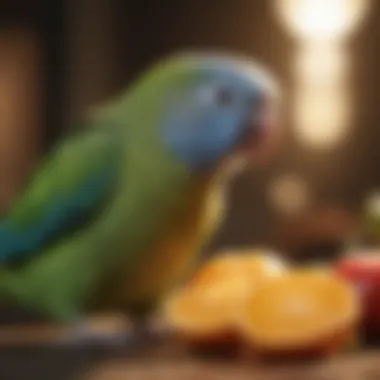
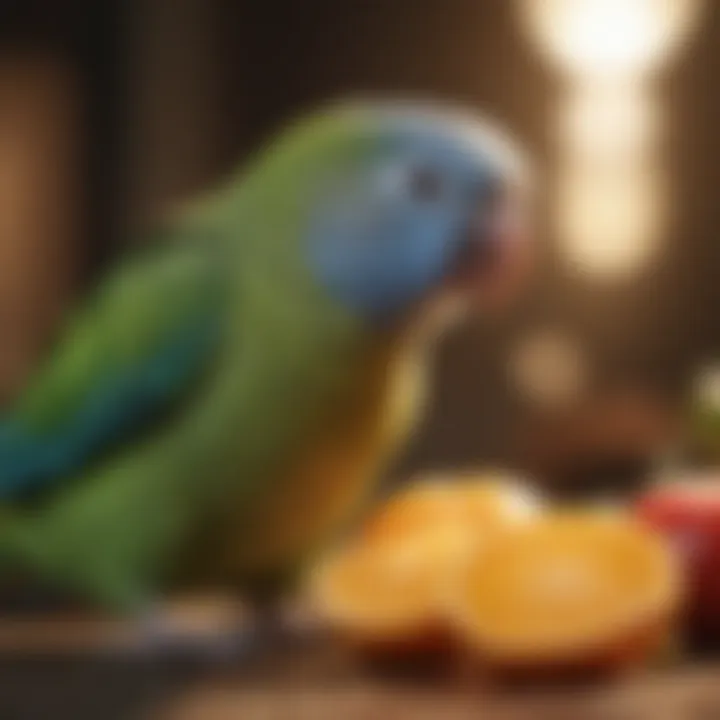
Defining Parakeets
Parakeets, commonly referred to as budgerigars or "budgies," belong to the parrot family and are small to medium-sized birds. They are known for their bright colors and playful demeanor. The term "parakeet" encompasses various species, but all share a few traits such as strong beaks, the ability to mimic sounds, and social behaviors. Defining what makes a parakeet a parakeet helps in understanding their needs and characteristics, setting the foundation for proper care.
Common Species
Parakeets come in various species, each with unique traits. Understanding these common species aids in selecting the right type for pet ownership.
Budgerigar
The budgerigar is perhaps the most popular parakeet species, known for its ability to mimic human speech and cheerful personality. They are social birds that thrive in pairs or small groups. Their approachable nature makes them a favorite for many pet owners. The budgerigar's key characteristic is its varied color mutations, ranging from green to blue and even yellow. This variety makes them quite visually appealing. One notable advantage of budgerigars is that they can learn to talk and perform tricks, making them engaging companions.
Cockatiel
Cockatiels, often considered a parakeet, are slightly larger than budgerigars and are known for their charming crests and whistling abilities. Their gentle personality and ease of training contribute to their popularity. Cockatiels often bond closely with their owners and are recognized for their playful nature. An advantage of having a cockatiel is their ability to socialize well with people and other birds alike. However, their larger size may require a more spacious cage compared to smaller species.
Lineolated Parakeet
The lineolated parakeet, often called the "linnie," is less common than the budgerigar or cockatiel but is equally lovely. These birds can display a range of colors, including green, blue, and yellow. A key characteristic of lineolated parakeets is their gentle demeanor, making them suitable for first-time bird owners. They are known for being quiet, which is advantageous for those seeking a less vocal companion. However, their less social nature compared to budgies may require additional effort in bonding.
Natural Habitat
Understanding the natural habitat of parakeets gives valuable insight into their care requirements. Knowing where parakeets come from helps owners replicate those conditions as closely as possible.
Geographical Distribution
Parakeets are native to various regions, with specific species found in Australia, South America, and Asia. Budgerigars, for instance, are originally from Australia, where they thrive in open grasslands and shrublands. This geographical distribution emphasizes the need for owners to provide a spacious environment within their cages to mimic their native open spaces. Recognizing how their natural habitats vary informs owners about the best practices for housing and care.
Environmental Conditions
In their natural world, parakeets are accustomed to warm climates with access to sunlight, water, and various natural food sources. This understanding of environmental conditions highlights the necessity of simulating these aspects in captivity. Providing ample light, clean water, and a balanced diet contributes to their overall health. Regular exposure to sunlight is essential, as it aids in vitamin D synthesis and supports their well-being. Therefore, creating a habitat that reflects these conditions can lead to happier and healthier parakeets.
Setting Up the Ideal Habitat
Creating a suitable habitat for parakeets is essential for their overall health and well-being. The environment where these birds live impacts their behavior, physical condition, and longevity. When setting up their habitat, careful consideration must be given to the cage, its location, and what accessories it contains. Each of these factors plays a critical role in making the parakeets comfortable and ensuring their needs are met.
Choosing the Right Cage
Size Considerations
The size of the cage is a foundational element of parakeet care. Choosing a larger cage over a smaller one directly benefits the birds. A spacious cage allows parakeets to spread their wings, move around freely, and engage in natural behaviors like climbing and flying short distances. Ideally, a cage should be at least 24 inches wide, 18 inches deep, and 24 inches tall for a pair of parakeets. This setup encourages healthy movement and reduces stress.
Another aspect of size considerations includes the layout of the cage. The internal configuration can affect how the birds use the space. A multi-level cage can offer more area for exploration compared to a single-level option. However, a larger cage will require a commitment to cleaning and maintenance.
Material Choices
Cage materials influence both the durability and safety of your parakeet's environment. Stainless steel and powder-coated metal cages are popular choices due to their strength and resistance to rust and corrosion. These materials ensure that the cage lasts longer while providing a safe home.
Avoid cages made from untreated wood, as they can deteriorate quickly and may harbor unhealthy bacteria. Plastic cages, while lightweight and inexpensive, might not be sturdy enough for active parakeets. It is critical to prioritize material quality in your selection.
Cage Location
Light Requirements
Proper lighting is crucial for the health of parakeets. Ideally, their cage should be placed where it can receive natural daylight but not direct sunlight for extended periods. Sunlight helps in vitamin D synthesis, which is vital for calcium absorption, promoting healthy feather growth and bone strength.
However, too much direct sunlight can lead to overheating and stress. Therefore, balanced light exposure is essential to support their well-being and activity levels. Often, cages positioned near a window provide a good natural light source without being overly harsh.
Noise Levels
Noise levels in the environment can impact the stress levels of parakeets. They are sensitive birds, and excessive noise can lead to anxiety and unwanted behaviors. Placing their cage in a quieter part of the house, away from loud appliances and high traffic areas, helps create a serene habitat.
A calm environment allows the birds to feel secure and more comfortable in their space, encouraging social behavior and interaction with their owners. Smart positioning of the cage contributes significantly to your parakeet's adaptation and overall happiness.
Essential Accessories
Perches
Perches are vital for a parakeet's comfort and health. They should vary in diameter and material to promote foot health. Natural wood perches, especially ones made from non-toxic hardwoods like pine, provide variety in texture that encourages exercise. Many parakeets like to preen and chew on their perches as well. Therefore, choosing the right type of perch can influence both their physical and mental stimulation.
A good arrangement of multiple perches at different heights encourages climbing and hopping, which are essential behaviors for parakeet well-being.
Toys and Enrichment
Toys and enrichment activities assist in keeping parakeets mentally stimulated. They can prevent boredom, which is often a cause of destructive behavior or stress. For example, swing toys, bells, and foraging toys can provide physical and intellectual challenges.
Incorporating multiple toys, along with rotating them regularly, keeps the parakeet engaged. Select toys made from bird-safe materials to ensure their safety while they play, adding significant joy to their daily lives.
Food and Water Bowls
Food and water bowls must be easily accessible and cleaned regularly. Stainless steel bowls are beneficial since they are easier to sanitize and are more durable compared to plastic options. It is best to use appropriately sized bowls to ensure that parakeets can eat and drink comfortably without spilling.
Additionally, considering the placement of the bowls within the cage is also important. They should be positioned away from perches to minimize contamination from droppings, which maintains both hygiene and healthier feeding conditions. Regularly checking and refreshing their water supply can further enhance their quality of life.
"The environment where your parakeet lives significantly impacts their overall happiness and health. A well-thought-out habitat can make a huge difference."
Nutritional Needs of Parakeets
Understanding the nutritional needs of parakeets is crucial for fostering their health and long-term well-being. A well-balanced diet enables these birds to thrive, as it supports their energy levels, feather quality, and overall mood. Ensuring proper nutrition helps prevent dietary deficiencies and related health issues. Parakeets are not only captivating pets, but also require meticulous care that includes attention to their feeding habits.
Basic Dietary Components
Seeds
Seeds are often considered a staple in a parakeet's diet. They are a source of energy and can provide essential fatty acids. The key characteristic of seeds is their high-fat content. This makes them popular among bird owners, who tend to feed them as main sources of nutrition. However, it is important to note that seeds alone do not provide all necessary nutrients. Parakeets may become overweight or face nutrition-related health concerns if seeds form the bulk of their diet. Seed-based diets lack crucial vitamins and minerals essential for a balanced intake.
Pellets
Pellets are designed to be nutritionally complete. This makes them a beneficial choice for parakeet owners aiming for a balanced diet. Pellets can contain a mix of grains, seeds, and vitamins. Their unique feature is that they are formulated to prevent selective eating, which is common with seed diets. While pellets may be a bit more expensive than seeds, their overall nutritional profile means they are often the better option for maintaining a healthy parakeet. Some birds may take time to adjust to pellets, so gradual introduction can be necessary.
Fresh Vegetables
Fresh vegetables are an essential part of a parakeet's diet. They provide not only vitamins and minerals but also hydration. Leafy greens like spinach and kale are good choices. Vegetables are beneficial because they introduce variety and stimulate the bird's appetite. Their unique feature is high water content, which helps keep parakeets hydrated. Despite their advantages, fresh vegetables can spoil quickly, requiring regular monitoring and replacement. Therefore, incorporating them into daily feeding should be done with care.
Supplemental Foods
Fruits
Fruits can be a delightful addition to a parakeet's diet, providing natural sugars and additional nutrients. Their key characteristic is their rich vitamin content, especially vitamin C. Fruits such as apples, berries, and bananas can be exciting choices for birds. However, fruits should only complement a parakeet's diet because they can be high in sugar. Overconsumption may lead to weight issues or digestive problems.
Nuts
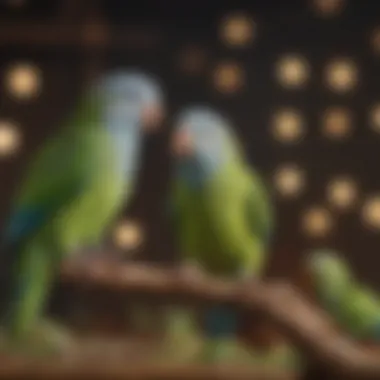
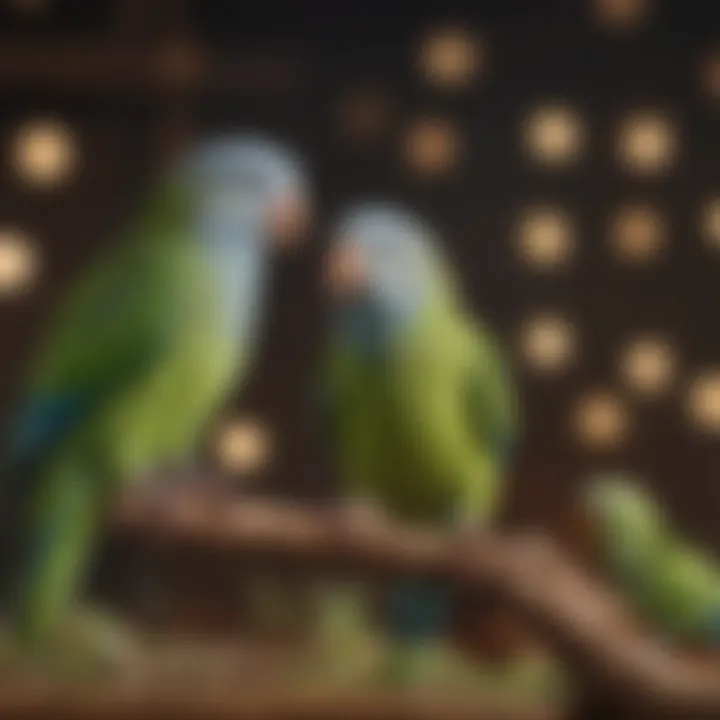
Nuts serve as an excellent source of proteins and fats. They are a beneficial supplemental food, but should be offered sparingly. The key characteristic of nuts is their high-calorie content, making them more of a treat than a regular diet component. They offer unique nutrition benefits, but overfeeding can result in obesity and related health concerns. Thus, providing nuts in moderation is essential.
Calcium Sources
Calcium sources are vital for parakeets, especially for breeding females. These sources can include cuttlebone or mineral blocks. Calcium supports strong bones and healthy egg production. Their key characteristic is that they prevent calcium deficiency, which can lead to severe health issues. In general, integrating these sources into feeding is wise, but they should not replace other dietary elements.
Common Dietary Mistakes
Excessive Seed Diets
Relying too heavily on seed diets is a common mistake among bird owners. While seeds are tasty, they lack crucial nutrients. The high-fat content in seeds can lead to obesity and nutritional deficiencies. This dietary mistake ultimately can result in serious health issues, such as liver disease or heart problems. Understanding the risks is vital for keeping your parakeet healthy and energetic.
Neglecting Fresh Foods
Ignoring the importance of fresh foods is another frequent error. Fresh fruits and vegetables are necessary for a balanced diet. A lack of variety may not only make meals boring for the bird but also can lead to deficiencies in essential vitamins and minerals. Ensuring that fresh options are available daily can improve the overall health and happiness of your parakeet.
Behavioral Insights
Understanding the behavior of parakeets is crucial for anyone considering their care. Behavioral insights provide a clear window into the needs and habits of these birds. By grasping these facets, owners can create a more harmonious living environment and ensure the well-being of their feathered friends. Parakeets are inherently sociable and require interaction, not just to thrive but also to develop strong bonds with their owners. This guide will help highlight the importance of these insights and how they can influence parakeet care.
Social Structure
Flocking Behavior
Flocking behavior is an essential characteristic of parakeets. In the wild, these birds naturally form flocks, which provide safety in numbers and social interaction. This behavior fosters a sense of companionship and reduces stress among parakeets. For those who own parakeets, understanding this aspect is vital. It allows for the arrangement of social settings, either by housing multiple parakeets together or ensuring regular interaction with their human caregivers. The unique feature of flocking behavior lies in its role in communication. Birds that flock often engage in vocalization and physical gestures, which helps solidify their social structure. The benefit of encouraging this behavior is that it decreases loneliness and promotes activity, creating a healthier and happier bird.
Interaction with Humans
Parakeets interact well with humans, often seeking their companionship. The key characteristic here is their vibrant personalities. They thrive on engagement and tend to mimic sounds and words, which can strengthen the bond between bird and owner. This human interaction is beneficial because it encourages mental stimulation and reduces feelings of isolation. Owners should prioritize quality time spent with their birds for their emotional health. However, excessive handling or lack of socialization can lead to stress, thus an appropriate balance must be maintained. Owners need to foster an environment where interaction is fun and non-threatening, ensuring the parakeet feels secure while exploring new social dynamics.
Understanding Body Language
Common Signals
Parakeets communicate through various signals. Recognizing these common signals is key to understanding their needs and emotions. Posture, tail movement, and vocalizations convey important information. For instance, a parakeet that fluffs its feathers may be feeling warm or calm, while one that puffs up could be feeling threatened. This knowledge helps in assessing the bird's mood and responding appropriately. Understanding these signals can enhance the connection between the bird and owner. However, misinterpretation of these signals can lead to stress or discomfort for the bird.
Mood Indicators
Mood indicators offer a glimpse into the emotional state of parakeets. For example, a parakeet that is chirping and active is likely content, while one that is quiet and withdrawn may be feeling unwell or stressed. This aspect is beneficial because it allows owners to adjust care strategies according to the bird's emotional state. Unique features of mood indicators include subtle cues, such as changes in coloring or positioning. Recognizing these signs helps in timely intervention when necessary. However, while observing mood indicators is helpful, relying solely on this information without considering other care factors may result in overlooking underlying health issues.
Training Techniques
Basic Commands
Teaching basic commands is a fundamental part of training parakeets. This practice not only helps in communication but also provides mental stimulation. Key commands, such as "step up" or "come here," can facilitate better interaction between the bird and its owner. This training is popular since it develops a trusting relationship. The unique aspect of basic commands is that they can be reinforced during daily interactions, making learning a natural part of their routine. However, without consistency, the effectiveness of such training may diminish over time.
Positive Reinforcement
Positive reinforcement plays a pivotal role in training parakeets. This technique involves rewarding desired behaviors, which encourages them to repeat those actions. The key characteristic of this method is its focus on encouragement rather than punishment. Using treats or praise makes the training process enjoyable for both the bird and owner. This approach is advantageous as it fosters a positive bond and reduces fear in the training environment. However, it requires patience and time; a hasty approach can lead to frustration and hinder progress.
Health Considerations
Addressing health considerations is vital for the longevity and well-being of parakeets. These small birds, known for their social nature and vibrant colors, require attentive care to avoid health issues that can arise from neglect or misunderstanding of their needs. This section aims to delve into essential aspects, such as recognizing symptoms of illness, scheduling regular health assessments, and implementing preventive healthcare measures. By prioritizing these elements, parakeet owners can foster a nurturing environment that promotes the overall health of their feathered companions.
Recognizing Illness Symptoms
Changes in Behavior
Monitoring changes in behavior offers insights into a parakeet’s health. Sudden shifts, such as increased aggression or lethargy, can indicate underlying health problems. A parakeet that generally enjoys interaction may withdraw or stop vocalizing when unwell. Recognizing these behavioral changes can lead to early detection of health issues, prompting quicker intervention. This is crucial as an early response may prevent more severe health concerns. However, it is essential to differentiate between occasional behavior shifts and consistent patterns, which are more indicative of health issues.
Physical Signs
Observing physical signs is similarly important in assessing a parakeet's health status. Common signs include ruffled feathers, difficulty breathing, or changes in droppings. These signs are key indicators of health and can show something is amiss. Physical signs provide tangible evidence of a parakeet's condition, making it easier for owners to track issues. However, owners need to approach physical assessments systematically. Changes may sometimes be temporary, so context is vital in interpreting physical signs accurately.
Regular Health Assessments
Grooming Needs
Grooming needs form an integral part of a parakeet's routine health assessment. Regular grooming ensures that feathers remain clean and free of parasites. Additionally, maintaining a proper beak and claw length is essential, as overgrown beaks or claws can lead to complications. Incorporating grooming into regular assessments emphasizes hygiene and comfort for the bird. While some may view grooming as a purely aesthetic concern, it plays a significant role in identifying health issues early. Parakeets that are not groomed may show signs of stress or discomfort, indicating underlying health problems.
Veterinary Visits
Veterinary visits are crucial for proactive health management in parakeets. Scheduled check-ups allow for examination of any hidden health issues and vaccinations critical to prevent diseases. Frequent veterinary consultations foster better health outcomes, ensuring that birds receive appropriate vaccinations and nutritional advice. However, the challenge lies in the accessibility and availability of avian veterinarians, which may not be as widespread as general practitioners. Hence, finding a trusted avian vet is essential to the care plan.
Preventive Healthcare
Vaccination
Vaccination serves as a preventive measure against common diseases in parakeets. Protecting birds from contagious illnesses reduces the risk of outbreaks, especially in multi-bird households. Incorporating vaccination into health routines is a wise strategy that significantly enhances overall health security for parakeets. However, some owners may question the necessity of vaccinations if birds appear healthy. Education on the potential risks of neglecting vaccinations helps emphasize their importance in maintaining robust health among these birds.
Dietary Supplements
Dietary supplements can bolster a parakeet’s health, addressing potential deficiencies in their diet. These supplements may include vitamins and minerals essential for their well-being. Understanding the proper use of dietary supplements enhances nutritional balance, ensuring birds receive comprehensive care. However, it is vital for owners to consult with veterinary professionals before introducing supplements. Misuse or over-supplementation may lead to more health issues than benefits, so guidance is essential in this area.
Providing Enrichment
Providing enrichment is vital to ensuring the well-being of parakeets. These birds are naturally inquisitive and social, making it essential to create an engaging environment that caters to their instincts. A lack of mental and physical stimulation can lead to stress, behavioral issues, and health problems. Enrichment not only helps to prevent boredom, but it also encourages natural behaviors, promotes exercise, and improves the overall quality of life for your parakeets.
Types of Enrichment
Physical Activities
Physical activities for parakeets include flying, climbing, and engaging in toys that promote movement. Providing opportunities for exercise is crucial for maintaining their physical health. A spacious cage with vertical design and various perches will enable your parakeets to stretch their wings and climb safely. Additionally, toys designed to encourage movement, such as swings and ladders, can be beneficial.
The key characteristic of physical activities is their contribution to fitness, which is essential for preventing obesity and other health issues. While some enrichment activities may require supervision, they can significantly enhance a parakeet's quality of life.
A unique feature of physical activities is the chance for social interaction, as parakeets often play together. The main advantage is that it allows them to burn off excess energy. However, a downside may be the risk of injury if proper precautions are not taken.
Mental Stimulation
Mental stimulation is equally important in parakeet care. This can include puzzle toys, foraging opportunities, and varied interactions that challenge their intellect. Providing variety in toys and activities prevents monotony, keeping their minds sharp and engaged.
The key characteristic of mental stimulation is that it mirrors the natural challenges parakeets face in the wild. Engaging them in problem-solving tasks can foster cognitive development, making them happy and healthier birds. These activities can improve their emotional well-being and reduce feelings of loneliness.
Unique features of mental stimulation involve using toys that dispense treats or require manipulation to access food. The advantage is that it encourages natural behaviors such as foraging, but the downside is that some toys may initially confuse or frustrate bird owners.
Interactive Playtime
Time Outside the Cage
Allowing parakeets time outside the cage is essential for their overall health. This time provides a change of scenery and allows them to explore their surroundings safely. Regularly scheduled out-of-cage time can improve their social behavior and provide opportunities for exercise.
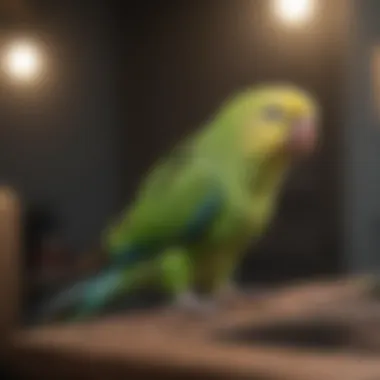
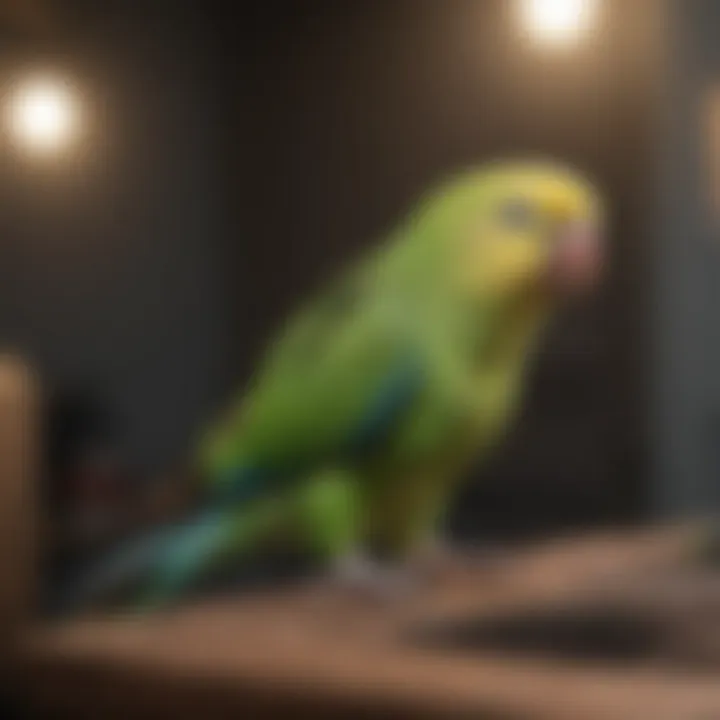
A key characteristic of this activity is the freedom it offers, enabling parakeets to showcase their natural instincts. It is very beneficial for their mental and physical health, as it mimics their natural flight behavior.
The unique feature of this playtime is the bonding experience it provides. Owners can engage with their parakeets, strengthening the bond. A downside is the need for close supervision to ensure safety and prevent accidents.
Safe Environments
Creating safe environments during playtime is crucial. This includes removing hazards such as toxic plants, sharp objects, and small items that can be ingested. Additionally, ensuring that windows and doors are secure helps prevent accidental escapes.
The key characteristic of safe environments is the peace of mind it offers to parakeet owners. It is an important consideration to protect your birds, helping ensure enjoyable interactions during playtime. The unique feature is that proper safety measures enable birds to explore with less stress.
However, the downside can be the meticulous preparation required, which may take time and effort. Ensuring a safe environment is a high priority.
Social Interaction
Bonding Activities
Bonding activities play an important role in solidifying the connection between owners and parakeets. Regular interactions, such as speaking softly, offering treats, and engaging in gentle handling techniques can cultivate trust. This not only benefits the bird's social development but also enriches the owner's experience.
The key characteristic of bonding activities is their contribution to emotional security for the birds. They help in reducing fear and anxiety. The unique feature is that bonding activities foster companionship, ensuring your parakeets are comfortable and happy in their environment.
An advantage is increased sociability, but the downside is that building trust can take time, especially with timid birds.
Companionship Options
Companionship options can further enhance the lives of parakeets. Many owners choose to house multiple parakeets together, allowing for natural social interactions. If potential new companions are introduced carefully, they can provide emotional support and reduce loneliness when owners are not home.
The key characteristic here is the fulfillment of social needs. Parakeets are flock animals, and having companions can lead to enriched lives. A unique feature involves watching social dynamics unfold and learning about each bird's personality.
The main advantage is that they can entertain and comfort each other. Conversely, the downside is the need for careful introductions to avoid territorial behaviors.
Providing enrichment through physical activities, mental challenges, and social interaction is crucial for the well-being of your parakeets. A well-rounded approach ensures healthy, happy birds.
Creating a Safe Environment
Creating a safe environment is essential for the well-being of parakeets. These birds are naturally curious but also vulnerable to various hazards that can lead to injury or illness. A safe space promotes their health and happiness, allowing them to thrive. This section looks at identifying hazards and effectively bird-proofing your home.
Identifying Hazards
Toxic Plants
Toxic plants are a significant concern for parakeet owners. Many common household plants can be harmful or even fatal to birds if ingested. Key characteristics of toxic plants include certain alkaloids or minerals that can disrupt bodily functions. Popular examples of toxic plants include philodendrons, poinsettias, and lilies. The unique feature of these plants is their widespread availability, which makes it easy to overlook their dangers. By removing or safely placing these plants out of reach, owners can avert potential health risks for their birds.
Dangerous Objects
Dangerous objects are another crucial aspect to consider. This includes sharp items, small parts that can be swallowed, or anything that poses a strangulation risk. Key characteristics of dangerous objects often include metallic surfaces or small components. Misplacing these items can lead to severe accidents. The unique feature here is that many of these objects are commonly found in households, making it easy for birds to encounter them. Ensuring that the living area is free of such hazards will reduce the risk of injury significantly.
Bird-Proofing Your Home
Electrical Cords
Electrical cords pose a serious hazard for parakeets. They can chew on these cords, which may lead to electrocution or severe injury. Key characteristics of electrical cords include their flexibility and appeal to the birds who enjoy chewing on various textures. Notable benefits of addressing this hazard are clear; by organizing and concealing cords, owners can create a safer environment. This unique feature shows the importance of proactive safety measures that keep birds at a distance from these risks.
Windows and Balconies
Windows and balconies can be dangerous if not properly secured. Parakeets are adventurous and may fly toward these openings. Key characteristics of these areas include accessibility and visibility that may attract birds. Easy access to windows and balconies is a key feature that can lead to dangerous falls or escapes. It's vital for owners to put up screens or barriers to prevent accidental tumbles or wandering outside. This preventative step plays an important role in maintaining a safe and secure environment for parakeets.
Understanding Lifespan and Aging
Understanding the lifespan and aging of parakeets is crucial for their care. As parakeets age, their needs and behaviors can change significantly, making it essential for owners to adapt their care strategies accordingly. Knowing how long you can expect your parakeet to live helps in planning their environment and lifestyle. It also aids in identifying aging-related health issues early, ensuring a longer and healthier life for your feathered friend.
Average Lifespan
Species Variability
The average lifespan of parakeets varies among different species. For example, the Budgerigar typically lives for about 5 to 10 years, while the Cockatiel can live up to 15 years or more. Understanding this variability is important because it informs owners about what to expect concerning care needs as their parakeet ages. Different species may have unique health concerns that become more significant as they age. Choosing a species with a compatible lifespan with your lifestyle can be beneficial. It means you can be more prepared and informed as your parakeet grows older. For instance, breeding or less common species may have specific needs that can make their care more complex as they age, which can be both an advantage and disadvantage.
Impact of Care
The impact of care on the lifespan of parakeets is significant. Quality of care can enhance their longevity. Factors such as diet, environmental stability, and social interaction play vital roles. A well-balanced diet rich in nutrients helps prevent health issues associated with aging. Furthermore, routine veterinary check-ups allow owners to catch potential problems early. Owners committed to understanding and meeting the specific needs of their parakeets can often see their birds live far longer than average. Thus, caring for your parakeet directly affects how long they live, presenting a clear case for the importance of proper care over the years.
Signs of Aging
Recognizing signs of aging in parakeets ensures owners can make appropriate adjustments to their care. Changes in appearance and behavior often occur as birds age, so being observant is essential.
Physical Changes
Physical changes are some of the most apparent signs of aging in parakeets. As they grow older, their feathers may become dull or less vibrant. Additionally, a decline in mobility can happen, meaning they might prefer resting over flying. Recognizing these physical changes early allows owners to adapt their bird's environment, providing easier access to food and water. It can encourage older birds to remain active, which is beneficial for their overall health.
Behavioral Adjustments
Behavioral adjustments in aging parakeets can indicate their shifting needs. For example, older parakeets might become less social or more irritable than their younger counterparts. They may also be more prone to spending time in quieter areas of their cage. Such changes can tell owners a lot about their bird's comfort levels and health. By understanding these adjustments, owners can make necessary changes to the bird's environment and social interactions, ensuring that aging parrots remain happy and healthy. Awareness of these signs helps maintain an enriching life for the aging pet.
Integrating New Parakeets
Integrating new parakeets into your home is a critical topic for any bird owner. This process can determine the long-term happiness of your birds. Understanding how to introduce them to existing pets, as well as establishing routines, helps in creating a more harmonious environment.
Introducing to Other Pets
Assessment of Compatibility
Assessing the compatibility of new parakeets with existing pets is essential. Different species exhibit varied behaviors. For instance, dogs and cats might see birds as prey. This aspect influences how you approach introduction. Evaluating the temperament of your pets can prevent conflicts.
- Key characteristics: Knowing if your existing pets are calm or aggressive strengthens your strategy.
- Benefit: A successful assessment can lead to a peaceful coexistence among pets.
- Unique feature: This approach allows for tailored introductions based on specific personalities, which is beneficial, but it requires keen observation.
Supervised Preambles
Supervised introductions are highly recommended when integrating new parakeets with other animals. This method keeps all pets safe during the process. With supervision, you can intervene if tensions arise.
- Key characteristic: This controlled approach minimizes stress for both new and existing pets.
- Benefit: A safe environment fosters trust among pets and reduces potential anxiety.
- Unique feature: Supervised introductions are flexible, allowing you to adjust duration and distance based on comfort levels. However, it can be time-consuming.
Establishing a Routine
Establishing a routine is crucial for acclimating new parakeets. Routine provides stability, helping them feel more secure in their new environment. Consistency helps manage expectations in their daily lives.
Feeding Schedules
Feeding schedules are vital elements of establishing a routine. Birds thrive on consistency. Regular feeding times mitigate anxiety and promote healthy eating habits.
- Key characteristic: A structured schedule informs the parakeets when to expect food, contributing to a calm atmosphere.
- Benefit: It can facilitate bonding moments as they learn to associate you with their feeding times.
- Unique feature: A routine minimizes the likelihood of overfeeding, which can be a concern, but it demands proper time management.
Training and Interaction
Training and interaction should be part of the routine with new parakeets. Birds are intelligent and respond well to interaction, making it crucial for their social needs. Regular training sessions encourage mental stimulation.
- Key characteristic: These activities improve communication between you and your parakeets, enhancing the bond.
- Benefit: Positive interaction fosters a trusting relationship, making your parakeet feel secure.
- Unique feature: A consistent training schedule is useful, but you might face challenges in maintaining their attention.
Integrating new parakeets requires careful consideration and patience. The aim is to foster a peaceful and enriching environment for all pets.















